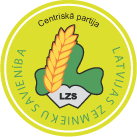Latvian Farmers' Union
Centre Party—Latvian Farmers' Union Centriskā Partija—Latvijas Zemnieku savienība | |
|---|---|
 | |
| Leader | Augusts Brigmanis |
| Founded | 1917 (original foundation, banned 1934), re-established 1990 |
| Headquarters | Riga |
| Membership (2017) | 1,464[1] |
| Ideology |
Agrarianism[2] Euroscepticism |
| Political position | Centre[2] |
| National affiliation | Union of Greens and Farmers |
| European affiliation | None |
| International affiliation | None |
| European Parliament group | Alliance of Liberals and Democrats for Europe[3] |
| Colours | Green, White |
| Saeima |
9 / 100
|
| European Parliament |
1 / 9
|
| Website | |
|
www | |
The Centre party Latvian Farmers' Union (Latvian: Centriskā partija Latvijas Zemnieku savienība, LZS) is a centrist and agrarian political party in Latvia.[2]
History
Founded in 1917, the party was the most influential conservative party in Latvia in the period from Independence in 1918 until the self-coup led by Kārlis Ulmanis in 1934, and the second most popular party overall after the Latvian Social Democratic Workers' Party. Ulmanis, who was a member of the party, banned all political parties after his coup including the LZS. As Latvia was subsequently occupied during the course of the Second World War, the party was dormant until it reformed in 1990 when Latvia regained its independence. Immediately after the restoration of independence, there existed several groups competing at elections to claim the legacy of the pre-war LZS. Since 2002 it has been part of the Union of Greens and Farmers (ZZS) coalition, along with the Latvian Green Party. The coalition now includes For Latvia and Ventspils and the Liepāja Party, who have cooperation agreements with the party allowing their members to be elected to the Saeima on the list of the Union of Greens and Farmers. The coalition faction is currently the third largest in the Saeima and the LZS has 9 out of the 21 seats it holds. Since May 2014 the party has had one member of the European Parliament, Iveta Grigule, who sits with the Alliance of Liberals and Democrats group, having previously sat with the Europe of Freedom and Direct Democracy group and as a Non-Attached Member.[3]
Election results
Parliament (Saeima)
| Election year | # of overall votes |
% of overall vote |
# of overall seats won |
+/– |
|---|---|---|---|---|
| 1920 | 126,434 | 17.8 | 26 / 150 |
|
| 1922 | 132,764 | 16.8 | 17 / 100 |
|
| 1925 | 125,070 | 15.0 | 16 / 100 |
|
| 1928 | 139,173 | 15.0 | 16 / 100 |
|
| 1931 | 118,443 | 12.2 | 14 / 100 |
|
| Banished under the Latvian Soviet Socialist Republic | ||||
| 1993 | 119,116 | 10.7 | 12 / 100 |
|
| 1995[lower-alpha 1] | 60 498 | 6.4 | 8 / 100 |
|
| 1998 | 23,732 | 2.5 | 0 / 100 |
|
| 2002[lower-alpha 2] | 93,759 | 9.5 | 9 / 100 |
|
| 2006[lower-alpha 3] | 151,595 | 16.8 | 14 / 100 |
|
| 2010[lower-alpha 4] | 190,025 | 20.1 | 18 / 100 |
|
| 2011[lower-alpha 5] | 111,955 | 12.2 | 9 / 100 |
|
| 2014[lower-alpha 6] | 178,210 | 19.5 | 15 / 100 |
|
- ↑ Seats divided between list of the LZS and the Christian Democratic Union
- ↑ Union of Greens and Farmers list won 12 seats
- ↑ Union of Greens and Farmers list won 18 seats
- ↑ Union of Greens and Farmers list won 22 seats
- ↑ Union of Greens and Farmers list won 13 seats
- ↑ Union of Greens and Farmers list won 21 seats
References
- ↑ "Latvijā partijās daudzkārt mazāk biedru nekā Lietuvā un Igaunijā. Kāpēc tā?" (in Latvian). LSM.lv. 2 January 2018. Retrieved 1 July 2018.
- 1 2 3 Nordsieck, Wolfram (2014). "Latvia". Parties and Elections in Europe. Retrieved 21 May 2018.
- 1 2 "Liberals and Democrats adopt Latvia's stray MEP". Public broadcasting of Latvia. April 25, 2015. Retrieved April 28, 2015.
External links
- Official website
